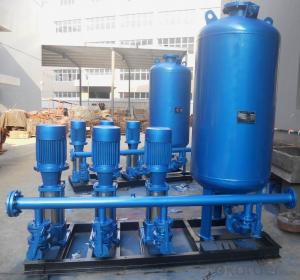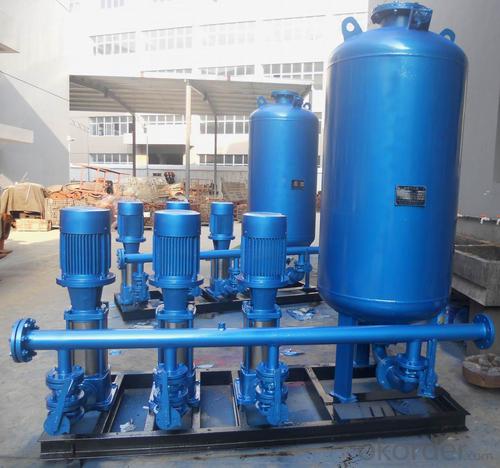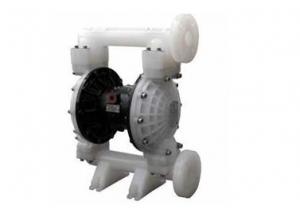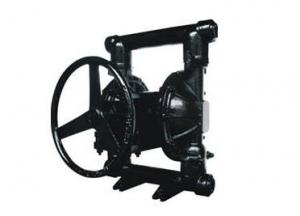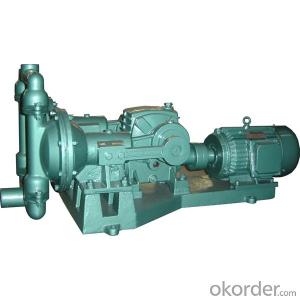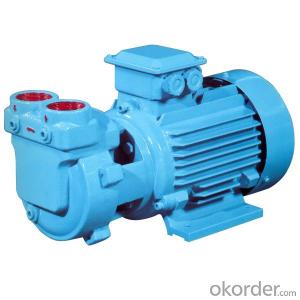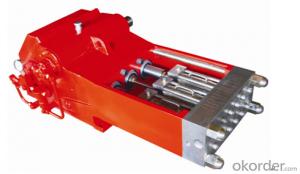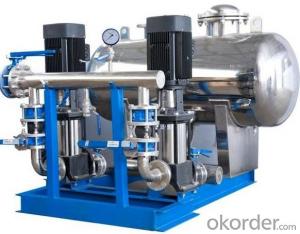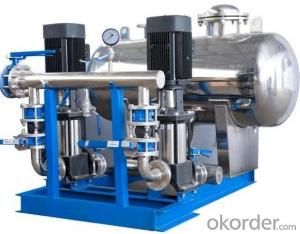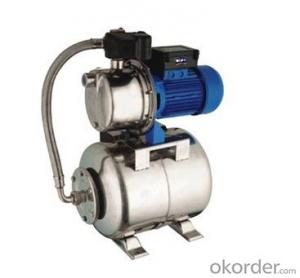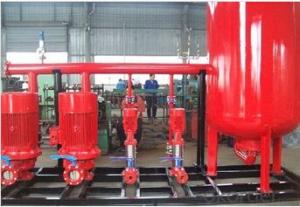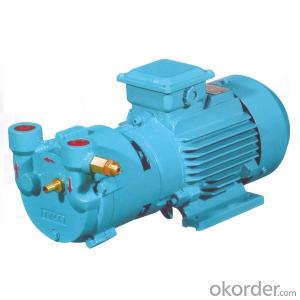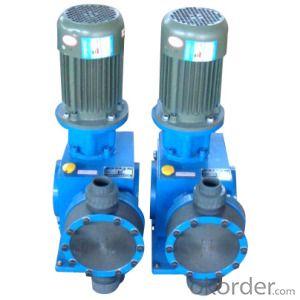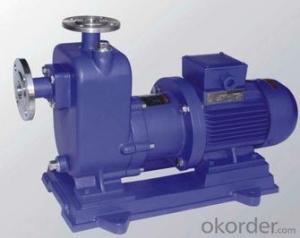Full Automatic Domestic Pressure Balancing Water Supply System
- Loading Port:
- China Main Port
- Payment Terms:
- TT OR LC
- Min Order Qty:
- -
- Supply Capability:
- -
OKorder Service Pledge
OKorder Financial Service
You Might Also Like
Performance & Advantages
Hydraulic Components With Large Flow Passage And Blockage-Resistance Design A Monitoring System For The Sealing Of The Oil Chamber
A Fully Automatic Safety Protection Control Box For Monitoring The Operation Of The Pump.
Range Of Application
Applicable For Chemical, Petroleum, Pharmacy, Mining, Papermaking, Pwoer Plant, Urban Sewage Treatment, Municipal Engineering And Public Facilities To Handle Sewage And Feculence Containing Particles.
Technology Parameters
Flow: 5-2000m3/H
Head: 5-50m
Rotary Speed: 580-2900r/Min
Calibre: φ 25-φ 400
Temperature: -15~+60 Degree
Working Pressure: ≤ 1.0mpa
- Q: Can an air pump be used for air-powered tools in automotive repair?
- An air pump is capable of being used in automotive repair for air-powered tools. These tools, also referred to as pneumatic tools, necessitate compressed air to function, which an air pump can supply. Examples of these tools encompass impact wrenches, air ratchets, air drills, air hammers, and various others. By compressing and storing the surrounding air in a tank, the air pump generates a reservoir of compressed air that can be harnessed to operate these tools. It is crucial to ascertain that the air pump can produce the requisite pressure and volume of air needed for the tools being employed.
- Q: Can an air pump be used for inflating air mattresses with integrated pillows?
- Indeed, the utilization of an air pump is viable when inflating air mattresses featuring integrated pillows. Employing an air pump offers a swift and effective means of inflating air mattresses, and the integrated pillows are no exception to this convenience. By simply connecting the pump to the inflation valve of the mattress, both the mattress and integrated pillows can be effortlessly filled with air. This not only saves time and exertion in comparison to manual inflation, but it also guarantees that the mattress and pillows are inflated to the desired level of comfort. It is imperative, however, to ensure the utilization of an appropriate nozzle or adapter that properly fits the inflation valve of the mattress, in order to achieve a secure and airtight seal.
- Q: Can an air pump be used for inflatable photo booths?
- Yes, an air pump can be used for inflatable photo booths as it helps in inflating and maintaining the structure of the booth.
- Q: The mechanic charged the high pressure pump into his colleague's anus and caused serious injuries. Does it constitute a negligent crime?
- The mechanic will be high pressure pump into the practical joke colleagues anal inflation caused serious injury, to look at the behavior of the charge if it is intentional, overconfident negligence, constitute the crime of negligence causing serious injury, if the structure of harm to society knowing that their behavior and laissez faire, constitute indirect intentional. According to the actual situation, it is more likely to constitute negligence and cause harm.The crime of causing serious injury by negligence refers to the act of negligently harming another person's body and causing serious injury.China's "criminal law" the fifteenth stipulation: should have foreseen that his act may endanger the society, because of negligence did not foresee, or have foreseen the gullible can be avoided, that the results of criminal negligence.The crime is manifested as negligence in subjective aspect, including negligent negligence and overconfidence fault. The former refers to the result that the victim's serious action should be foreseen in the event that the victim is seriously injured and is not foreseen because of carelessness; the latter is the result of having been foreseen and gullible to avoid the serious injury of the victim. The essential characteristics of the crime of negligent injury lie in the fact that the perpetrator has neither intentional homicide nor intentional injury, but only the result of negligence or overconfidence.
- Q: Are there any specific power requirements for operating an air pump in different countries?
- Yes, there may be specific power requirements for operating an air pump in different countries. The power requirements can vary based on the voltage, frequency, and plug type used in different regions. Therefore, it is important to consider these factors and ensure that the air pump is compatible with the local power supply or use appropriate adapters or converters if necessary.
- Q: Can an air pump be used for inflating air tents?
- Yes, an air pump can be used for inflating air tents. Many air tents are designed to be inflated using an air pump, which can make the setup process much quicker and easier compared to traditional pole tents. The air pump supplies a constant flow of air into the tent's inflatable beams, which quickly and efficiently inflate the structure. This eliminates the need for manual assembly and allows for a hassle-free camping experience. However, it is important to ensure that the air pump is compatible with the specific air tent model to prevent any damage or inefficiencies during inflation.
- Q: What are the different pressure settings available in air pumps?
- The different pressure settings available in air pumps can vary depending on the specific model and purpose. However, common pressure settings include low pressure (typically around 5-10 psi), medium pressure (around 10-20 psi), and high pressure (typically exceeding 20 psi). These settings allow users to adjust the air pressure output based on their specific needs, such as inflating tires, sports balls, or inflatable toys.
- Q: How can the oxygen pump in the tank be out of oxygen, or pumping water, but without oxygen?
- See your pump is still not vibration, don't move it at electric power is not over, if you see in trachea have folded gas barrier. If these two conditions are not predict is retiring. No bubble pump to remove the cleaning, if it is already too long if you use a small screwdriver to vent hole at large point on the line.
- Q: Can an air pump be used for inflating inflatable slides with splash pools?
- Yes, an air pump can be used for inflating inflatable slides with splash pools. Air pumps are designed specifically for inflating objects such as inflatable slides, pools, and other inflatables. They provide a constant flow of air, which helps to quickly and efficiently inflate the slide and splash pool. It is important to ensure that the air pump is compatible with the specific type and size of the inflatable slide, as different models may require different levels of air pressure. Additionally, it is recommended to follow the manufacturer's instructions and safety guidelines when using an air pump to inflate inflatable slides with splash pools.
- Q: Can an air pump be used in industrial applications?
- Yes, an air pump can be used in industrial applications. Air pumps, also known as air compressors, are commonly used in various industrial settings for a wide range of applications. They are used to generate and supply compressed air, which can be utilized in various processes such as powering pneumatic tools, operating machinery, providing air pressure for material handling systems, and in the production of various products. Industrial air pumps can be designed to meet specific requirements, such as high-pressure or high-volume applications, and they are available in various sizes and configurations to suit different industrial needs. Overall, air pumps are an essential component in many industrial operations and play a crucial role in enhancing efficiency and productivity.
Send your message to us
Full Automatic Domestic Pressure Balancing Water Supply System
- Loading Port:
- China Main Port
- Payment Terms:
- TT OR LC
- Min Order Qty:
- -
- Supply Capability:
- -
OKorder Service Pledge
OKorder Financial Service
Similar products
Hot products
Hot Searches
Related keywords
